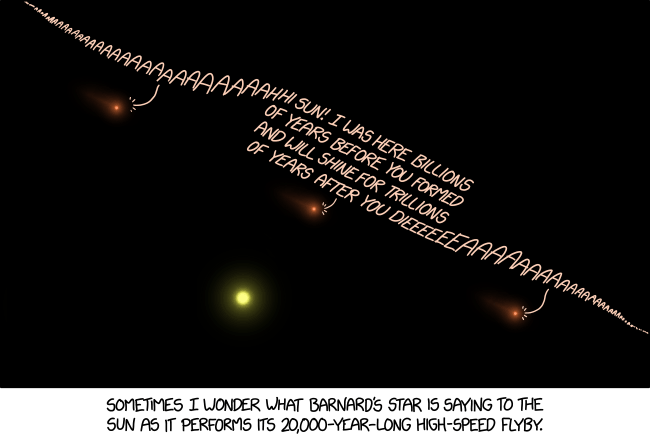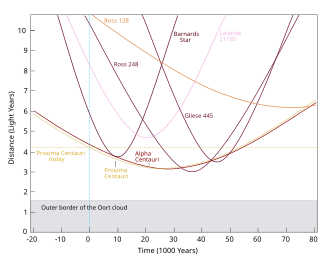Difference between revisions of "2062: Barnard's Star"
(→Explanation) |
Yngvadottir (talk | contribs) (→Explanation: ce) |
||
| Line 11: | Line 11: | ||
[[File:Near-stars-past-future-en.svg|thumb|300px|Distances to the nearest stars from 20,000 years ago until 80,000 years in the future]] | [[File:Near-stars-past-future-en.svg|thumb|300px|Distances to the nearest stars from 20,000 years ago until 80,000 years in the future]] | ||
| − | {{w|Barnard's Star}} is a very-low-mass red dwarf about 6 light-years away from Earth in the constellation of {{w|Ophiuchus}}. It is the fourth-nearest | + | {{w|Barnard's Star}} is a very-low-mass red dwarf about 6 light-years away from Earth in the constellation of {{w|Ophiuchus}}. It is the fourth-nearest known individual star to the Sun (after the three components of the Alpha Centauri system) and the closest star in the Northern Celestial Hemisphere. |
Barnard's Star is the star with the greatest apparent motion in the sky. Apparent motion is motion in the sky other than that caused by earth's rotation. Barnard's star is both very close to the sun (as these things go) and moving at a speed of more than 140 km/s toward the Sun. It will make its closest approach to the Sun in approximately 10,000 years, at a distance within about 3.75 light-years. After that the distance will increase again. | Barnard's Star is the star with the greatest apparent motion in the sky. Apparent motion is motion in the sky other than that caused by earth's rotation. Barnard's star is both very close to the sun (as these things go) and moving at a speed of more than 140 km/s toward the Sun. It will make its closest approach to the Sun in approximately 10,000 years, at a distance within about 3.75 light-years. After that the distance will increase again. | ||
| − | The image on the right shows different stars near the Sun over 100,000 years and it can be seen that none of them are getting closer than 3 light-years. This is a safe distance to our Solar System and the stars will not influence the orbits of the planets or smaller bodies. It's also obvious that much closer approaches never have happened since the Solar System | + | The image on the right shows different stars near the Sun over 100,000 years and it can be seen that none of them are getting closer than 3 light-years. This is a safe distance to our Solar System and the stars will not influence the orbits of the planets or smaller bodies. It's also obvious that much closer approaches never have happened since the Solar System formed 4.5 billion years ago because otherwise the nearly circular orbits of the planets in the same plane wouldn't be possible. |
=Transcript= | =Transcript= | ||
Revision as of 17:15, 22 October 2018
| Barnard's Star |
 Title text: "Ok, team. We have a little under 10,000 years before closest approach to figure out how to destroy Barnard's Star." "Why, does it pose a threat to the Solar System?" "No. It's just an asshole." |
Explanation
| This is one of 57 incomplete explanations: Please edit the explanation below and only mention here why it isn't complete. Do NOT delete this tag too soon. If you can fix this issue, edit the page! |
Barnard's Star is a very-low-mass red dwarf about 6 light-years away from Earth in the constellation of Ophiuchus. It is the fourth-nearest known individual star to the Sun (after the three components of the Alpha Centauri system) and the closest star in the Northern Celestial Hemisphere.
Barnard's Star is the star with the greatest apparent motion in the sky. Apparent motion is motion in the sky other than that caused by earth's rotation. Barnard's star is both very close to the sun (as these things go) and moving at a speed of more than 140 km/s toward the Sun. It will make its closest approach to the Sun in approximately 10,000 years, at a distance within about 3.75 light-years. After that the distance will increase again.
The image on the right shows different stars near the Sun over 100,000 years and it can be seen that none of them are getting closer than 3 light-years. This is a safe distance to our Solar System and the stars will not influence the orbits of the planets or smaller bodies. It's also obvious that much closer approaches never have happened since the Solar System formed 4.5 billion years ago because otherwise the nearly circular orbits of the planets in the same plane wouldn't be possible.
Transcript
| This is one of 30 incomplete transcripts: Do NOT delete this tag too soon. If you can fix this issue, edit the page! |
Discussion
Uh . . . I'm pretty sure that stars don't talk. 172.68.58.113 (talk) (please sign your comments with ~~~~)
- And squirrels don't ring. This comic can be absurd sometimes. 172.68.141.58 17:05, 22 October 2018 (UTC)
- [citation needed] --172.68.54.160 18:05, 22 October 2018 (UTC)
- Why are you so sure that stars don't talk? 162.158.38.70 18:23, 22 October 2018 (UTC)
- I think it was a NOVA doco where they describe the inner workings of the sun and how hydrogen atoms, photons, plasma, and magnetic flux interact, and it sounded a heck of a lot like the function of neurons and signals in the brain. Maybe I was just high, but I got to thinking that, with photons from every star in the universe connecting to every other star, the stars are in constant communication with eachother in some sort of neural-like network with each star having it's own neural-like network complete with it's own sentient thoughts (albeit probably far outside the realm of our imagination). FORTY TWO! 162.158.74.27 (talk) (please sign your comments with ~~~~)
- Obviously, stars, being in vacuum, don't talk in classic acoustic way. But they emit lot of light, which includes radio emissions ... and remember that properly encrypted signal is hard to recognize from random noise. -- Hkmaly (talk) 23:05, 22 October 2018 (UTC)
Stars can talk but usually don't. Maybe because they are under a lot of pressure ? 141.101.69.45 08:45, 24 October 2018 (UTC) BadJokeNinja
Am I'm the only one, who is reminded by the beginning "...AAAA" and the ending "EEEEEAAA..." to the "The Man Who Fell Sideways" comic?--162.158.94.20 12:17, 24 October 2018 (UTC)
"a small Red dwarf has a lifespan of about a trillion years." A trillion years? Any source for this? The universe is around 14 billion years old. 172.69.62.160 13:32, 24 October 2018 (UTC)comicreader
- That doesn't mean it's that old now. It means it will last that long, which means it's a relative youngster at this stage of its life. I'm sure a trillion years is a very general estimate for its lifespan, which is highly dependent on its mass. As for the source of this estimate, it's probably well-sourced on Wikipedia that serves as the source of much of the explanation's current content. Ianrbibtitlht (talk) 13:48, 24 October 2018 (UTC)
- And click the Wiki link for Red dwarf in the explanation. You will read: "...Red dwarfs therefore develop very slowly, maintaining a constant luminosity and spectral type for trillions of years, until their fuel is depleted. Because of the comparatively short age of the universe, no red dwarfs exist at advanced stages of evolution." --Dgbrt (talk) 18:34, 24 October 2018 (UTC)
Faster comunication than photons could be possible with plasma entanglement but I'm still skeptical as to whether or not stars are big giant sentient brains. Why is it traveling so fast I wonder... a remnant of some previous galactic merger?
Two points. First, a star called Gliese 710 will pass through the Solar System in about 1.3 million years. Predictions of how close it will come vary, but seem to cluster around 0.3 lighyears (ly) and 0.05 ly. Both estimates mean the star will pass through the Oort cloud. There is even a small chance it will pass just outside the Kuiper belt. This star is informally called "Uncle Jimbo's Star" because it's coming right at us. Second, your basic star-shaped star is an easy thing to study in detail and an easy thing to model. The sun has a radiative core; it cannot add fresh fuel. As a result, it burns up about 10% of its hydrogen and goes out. Barnard's star is convective throughout, so it constantly mixes fresh hydrogen into its core. As a result, Barnard's star will consume 50 - 80 % of its hydrogen before going out. The reacting masses of the Sun and Barnard's star are almost the same. Since the bolometric luminosity of Barnard's star is around 0.0035 that of the sun, it can reasonably be expected to last around 300 times longer - around 3 trillion years. That's a crude guess. More accurate models give an even longer life. Some of the really little ones will still be shining some 10 trillion years from now. -- Adeblanc (talk) 14:44, 2 February 2023 (please sign your comments with ~~~~)
Scholz's star has a mass of about 0.15 suns, vs. Neptune's 5.149x10-5 suns. Scholz's star passed about 52,000 AU from us, vs. Neptune's orbital radius of 30.1 AU. So at its closest approach, the star's gravitational influence on the inner solar system was (0.15/5.149x10^-5) * (30.1/52,000)^2 times that of Neptune, or 9.8x10^-4. BunsenH (talk) 22:37, 16 November 2024 (UTC)
